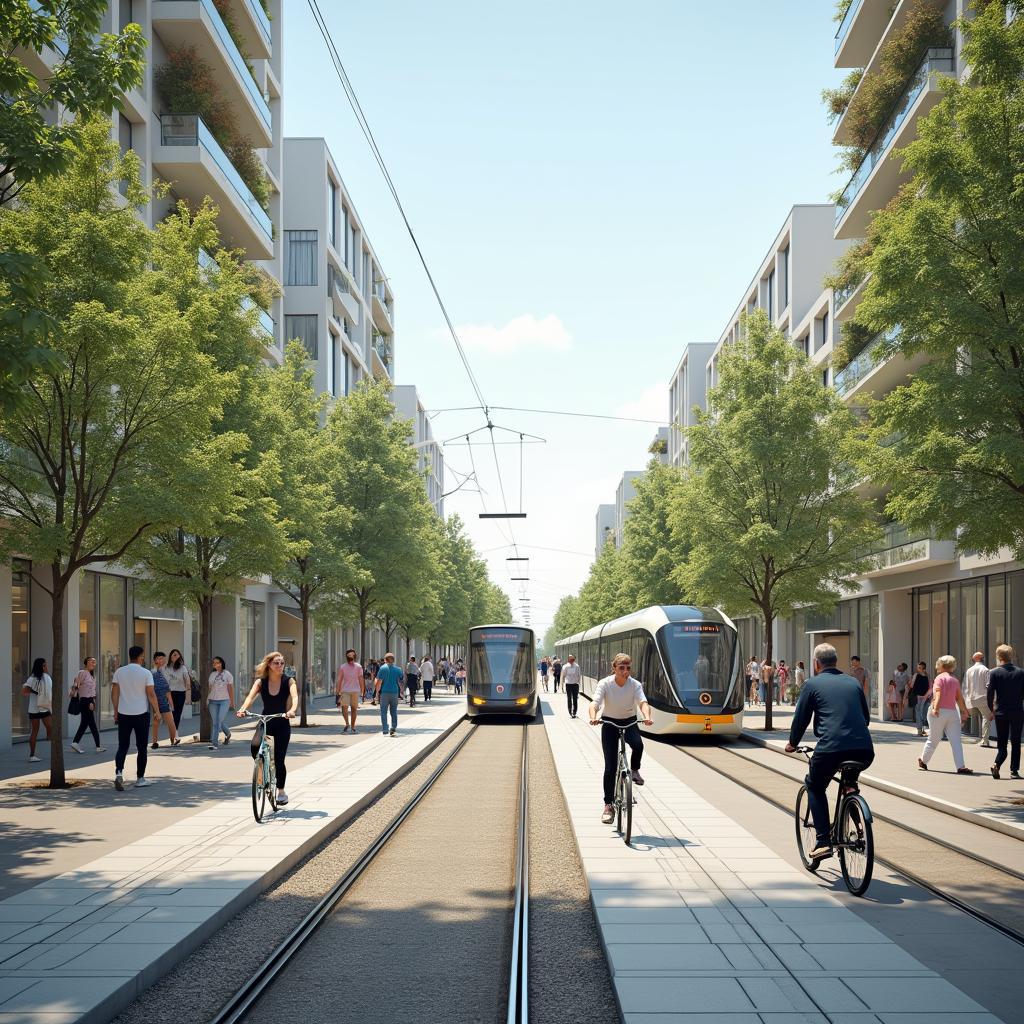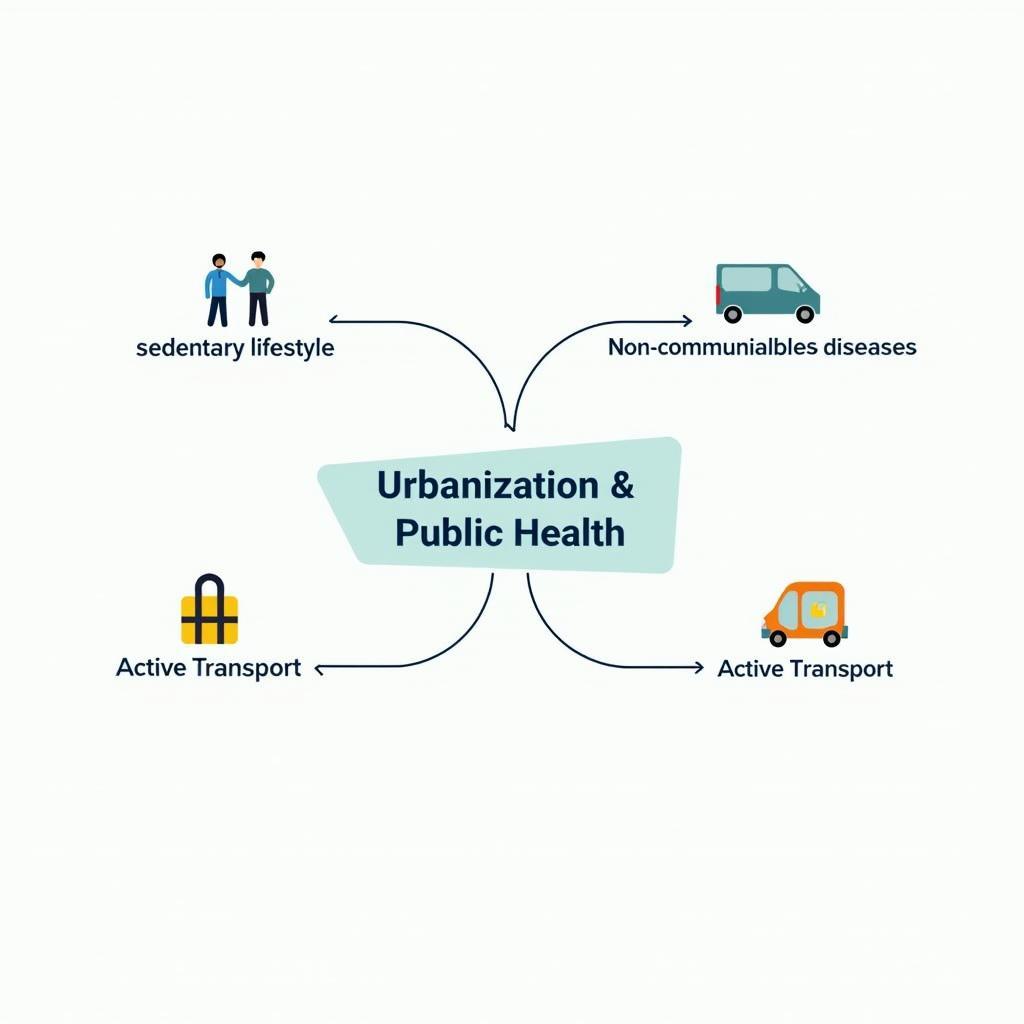Chủ đề Impact Of Urbanization On Public Health xuất hiện ngày càng thường xuyên trong IELTS Writing Task 2, vì quá trình đô thị hóa đang định hình sức khỏe cộng đồng toàn cầu. Đây là đề bài “hot” ở cả dạng discuss both views, causes–solutions và agree/disagree. Trong bài viết này, bạn sẽ học được: 3 bài mẫu hoàn chỉnh (Band 5-6, 6.5-7 và 8-9), phân tích chấm điểm theo 4 tiêu chí chính thức, từ vựng trọng tâm, 6 cấu trúc câu ăn điểm, cùng checklist tự kiểm trước–trong–sau khi viết.
Nội dung bài viết
- 1. Đề Writing Part 2
- 2. Bài mẫu Band 8-9
- Phân tích Band điểm
- Các yếu tố giúp bài này được chấm điểm cao
- 3. Bài mẫu Band 6.5-7
- Phân tích Band điểm
- So sánh với bài Band 8-9
- 4. Bài mẫu Band 5-6
- Phân tích Band điểm
- Những lỗi sai của bài – phân tích & giải thích
- Cách Cải Thiện Từ Band 6 Lên Band 7
- 5. Từ vựng quan trọng cần nhớ
- 6. Cấu trúc câu dễ ăn điểm cao
- 7. Checklist Tự Đánh Giá
- Kết bài
Một số đề thi tương tự đã được ghi nhận trên các nguồn uy tín (IELTS Liz, IELTS-Blog, British Council resources):
- “As more people move to cities, public health faces new challenges. What are the causes and solutions?”
- “Urbanisation has both positive and negative impacts on people’s health. Discuss both views and give your opinion.”
- “Governments should encourage people to move to regional towns to improve public health in cities. To what extent do you agree or disagree?”
Bài viết dưới đây chọn một câu hỏi phổ biến, phân tích kỹ dạng bài, cách triển khai dàn ý, và đưa ra ba bài mẫu ở ba mức band khác nhau để bạn đối chiếu, soi lỗi và cải thiện. Ngoài ra, bài còn tích hợp mẹo ngữ pháp, từ vựng học thuật và hướng dẫn quản lý thời gian – đặc biệt hữu ích cho thí sinh Việt Nam.
1. Đề Writing Part 2
Some people argue that urbanisation improves public health through better access to services, while others believe it undermines well-being due to pollution and stressful lifestyles. Discuss both views and give your own opinion.
Dịch đề: Một số người cho rằng đô thị hóa cải thiện sức khỏe cộng đồng nhờ tiếp cận dịch vụ tốt hơn, trong khi những người khác tin rằng nó làm suy giảm sức khỏe do ô nhiễm và lối sống căng thẳng. Hãy thảo luận cả hai quan điểm và nêu ý kiến của bạn.
Phân tích đề bài:
- Dạng câu hỏi: Discuss both views and give your opinion. Yêu cầu: trình bày hai lập luận trái chiều + nêu quan điểm cá nhân rõ ràng trong phần mở hoặc kết bài (tốt nhất ở cả hai).
- Thuật ngữ quan trọng:
- Urbanisation: quá trình dân cư tập trung vào đô thị.
- Public health: sức khỏe cộng đồng (bao gồm thể chất, tinh thần, tiếp cận y tế, dịch tễ).
- Well-being: phúc lợi/sức khỏe tổng thể, không chỉ thiếu bệnh.
- Lỗi thường gặp:
- Chỉ nói về giao thông/nhà ở mà lạc đề (thiếu liên hệ sức khỏe).
- Không cân bằng hai quan điểm, thiếu ví dụ cụ thể.
- Ý kiến cá nhân mờ nhạt, không nhất quán.
- Dùng số liệu bịa đặt; câu quá dài nhưng lỏng ý.
- Cách tiếp cận chiến lược:
- View 1: Lợi ích cho sức khỏe cộng đồng (dịch vụ y tế tập trung, tiêm chủng, nước sạch, xử lý rác thải, chương trình sàng lọc).
- View 2: Tác hại (ô nhiễm không khí/tiếng ồn, căng thẳng, lối sống tĩnh tại, nhà ổ chuột).
- Opinion: Lập trường có điều kiện (benefits materialize only with governance/urban planning); đề xuất giải pháp hợp lý.
 Hình ảnh so sánh tác động hai mặt của đô thị hóa đến sức khỏe cộng đồng trong IELTS Writing Task 2.
Hình ảnh so sánh tác động hai mặt của đô thị hóa đến sức khỏe cộng đồng trong IELTS Writing Task 2.
2. Bài mẫu Band 8-9
Một bài Band 8-9 cần: quan điểm rõ, lập luận cân bằng, ví dụ hợp lý, từ vựng học thuật chính xác, câu linh hoạt, mạch lạc cao.
Bài luận (khoảng 300 từ):
While cities are often portrayed as unhealthy spaces, they can also be engines of better population health when designed and governed well. On the one hand, urbanisation tends to concentrate expertise and infrastructure. In large cities, residents typically enjoy quicker access to hospitals, specialist clinics and preventive programmes such as vaccination or cancer screening. These systems benefit from economies of scale, allowing governments to roll out cost-effective, population-wide interventions. Moreover, dense neighbourhoods make active transport feasible: when sidewalks are safe and public transit is reliable, people can walk or cycle more, reducing the burden of non-communicable diseases.
On the other hand, the urban environment can impose substantial health costs. Air and noise pollution aggravate respiratory and cardiovascular conditions; long commutes and precarious employment intensify chronic stress, sleep deprivation and anxiety. In rapidly growing cities, poorly regulated housing may create informal settlements with overcrowding, inadequate sanitation and limited primary care, which elevate the risks of infectious outbreaks. Furthermore, sedentary jobs, ubiquitous fast food and limited green space can normalise unhealthy habits that accumulate over decades.
In my view, both pictures are accurate, but governance is the decisive variable. Urbanisation per se neither guarantees better health nor condemns people to illness; outcomes hinge on policy choices. Cities that enforce clean-air standards, expand affordable housing and integrate parks with mass transit can reap the health dividends of density. By contrast, places that prioritise car dependency and deregulated growth will likely entrench inequities. Therefore, the task for policymakers is not to slow urbanisation but to steer it: invest in primary care at the community level, mandate active-design principles in planning codes, and target vulnerable districts with tailored services. If these steps are taken, urban life can be not only longer, but also healthier and more equitable.
Phân tích Band điểm
| Tiêu chí | Band | Nhận xét |
|---|---|---|
| Task Response (Hoàn thành yêu cầu) | 8.5 | Trả lời đầy đủ cả hai quan điểm và nêu rõ opinion. Lập luận có chiều sâu, ví dụ hợp lý, không lan man. Thiếu số liệu cụ thể nhưng bù lại bằng phân tích chính sách. |
| Coherence & Cohesion (Mạch lạc & Liên kết) | 8.5 | Bố cục 4 đoạn rõ ràng; chủ đề câu mạnh; dùng tham chiếu và chuyển ý tự nhiên. Liên kết logic giữa “both sides” và “policy variable” mượt. |
| Lexical Resource (Từ vựng) | 8.5 | Từ vựng học thuật chính xác: economies of scale, preventive programmes, non-communicable diseases, active-design principles. Collocations tự nhiên, ít lặp. |
| Grammatical Range & Accuracy (Ngữ pháp) | 8.0 | Câu phức đa dạng, mệnh đề quan hệ, đảo ngữ ngầm, cụm phân từ. Hầu như không lỗi; có một vài câu dài nhưng được kiểm soát tốt. |
Các yếu tố giúp bài này được chấm điểm cao
- Trả lời trọn vẹn yêu cầu “discuss both” và “give your opinion” với lập trường có điều kiện.
- Dùng khung “governance as the decisive variable” để thống nhất lập luận.
- Collocations y khoa–chính sách chuẩn xác: “population-wide interventions”, “clean-air standards”.
- Ví dụ mang tính chính sách cụ thể: code thiết kế đô thị, primary care tại cộng đồng.
- Liên kết nguyên nhân–hệ quả rõ (density → active transport → NCD reduction).
- Từ nối tinh tế, không lạm dụng “Firstly/Secondly”.
- Kết luận không lặp ý máy móc, đưa ra định hướng hành động.
 Mô hình thành phố thông minh với không gian xanh và giao thông bền vững giúp cải thiện sức khỏe cộng đồng.
Mô hình thành phố thông minh với không gian xanh và giao thông bền vững giúp cải thiện sức khỏe cộng đồng.
3. Bài mẫu Band 6.5-7
Đặc điểm: phát triển ý tương đối tốt, có ví dụ, nhưng từ vựng/ngữ pháp chưa thật sắc; liên kết đôi lúc cơ học.
Bài luận (khoảng 260 từ):
Urbanisation affects public health in mixed ways. Some people say big cities provide better hospitals and doctors, which is true because specialists usually work in urban areas. Citizens can also reach preventive services more easily, such as vaccination or advice about diet and exercise. When public transport is convenient, people may walk more instead of driving. These factors could improve health outcomes.
However, many urban residents face pollution, noise, and stress from traffic. Long working hours and long commutes often lead to lack of sleep and unhealthy eating. In some fast-growing cities, there are slums with poor sanitation, which can spread diseases. Also, it is common that office jobs make people sit all day, so they become less active and gain weight over time. Green spaces might exist, but they are not always near people’s homes.
In my opinion, cities can promote good health, but only if local authorities plan carefully. They should control emissions, expand green areas, and encourage cycling. It would also be helpful to invest in primary healthcare in poor districts, because these communities are usually neglected. If governments coordinate transport, housing and health policies, the benefits of density will outweigh the disadvantages. Otherwise, urbanisation may continue to harm citizens’ well-being.
Overall, I believe the key is policy and enforcement. Urbanisation itself is not positive or negative; it depends on how a city is managed.
Phân tích Band điểm
| Tiêu chí | Band | Nhận xét |
|---|---|---|
| Task Response (Hoàn thành yêu cầu) | 7.0 | Trả lời đủ hai phía và có opinion rõ. Lập luận hợp lý nhưng ví dụ còn chung chung; chưa khai thác sâu cơ chế chính sách. |
| Coherence & Cohesion (Mạch lạc & Liên kết) | 7.0 | Bố cục hợp lý, chuyển ý rõ, nhưng một số đoạn mở–đóng hơi cơ học; thiếu các câu nối tinh tế giữa luận điểm. |
| Lexical Resource (Từ vựng) | 6.5 | Có cụm tốt (“benefits of density”, “primary healthcare”), nhưng vẫn lặp từ đơn giản (cities, people). Thiếu dải đồng nghĩa học thuật. |
| Grammatical Range & Accuracy (Ngữ pháp) | 6.5 | Câu phức có nhưng chưa đa dạng; một số cấu trúc lặp; lỗi nhỏ về mạo từ/giới từ không đáng kể. |
So sánh với bài Band 8-9
- Band 8-9 có khung lập luận “governance is decisive” xuyên suốt, còn bài 6.5-7 chỉ nêu “policy matters” nhưng chưa phân rã thành công cụ cụ thể.
- Từ vựng học thuật ở Band 8-9 giàu và chính xác hơn; bài 6.5-7 lặp từ thường, thiếu collocation nâng cao.
- Cấu trúc câu ở Band 8-9 đa dạng (cụm phân từ, mệnh đề quan hệ không xác định), còn bài 6.5-7 dùng câu đơn/câu ghép là chủ yếu.
4. Bài mẫu Band 5-6
Đặc điểm: trả lời đề nhưng phát triển ý nông, nhiều lỗi từ vựng–ngữ pháp, liên kết rời rạc. Dưới đây có đánh dấu lỗi để bạn nhận diện.
Bài luận (khoảng 255 từ):
Many people move to cities and this make public health better because there are many hospitals are in urban areas. People can get treatment faster and they don’t need to wait too long time. Also government can do campaigns for prevent diseases. For example, vaccination programs in big cities is more easy to organize.
However, urbanisation have negative impacts. Air pollution is very serious and it make peoples get asthma. Many workers spend long times for commuting, so they feel stress and eat fast food too many. There are also poor areas which don’t has clean water. In my city, some districts are too crowded that diseases spread fastly.
In my opinion I think city life is good for health if we have more stricter rules. The government should build parks and prohibit cars use in center. People must do exercise and eat vegetables. If we do like this, public health will be fine in the future and urbanisation will be full positive.
Overall, urbanisation has pros and cons but I believe with right decisions the situation can be improve.
Phân tích Band điểm
| Tiêu chí | Band | Nhận xét |
|---|---|---|
| Task Response (Hoàn thành yêu cầu) | 6.0 | Có nêu hai phía và opinion, nhưng phát triển ý còn chung, ví dụ mơ hồ. Kết luận sơ sài. |
| Coherence & Cohesion (Mạch lạc & Liên kết) | 5.5 | Liên kết cơ bản, chuyển ý đột ngột; lặp ý, thiếu câu chủ đề mạnh. |
| Lexical Resource (Từ vựng) | 5.5 | Từ vựng đơn giản, collocation sai/thiếu tự nhiên (“do campaigns for prevent diseases”). Lặp từ. |
| Grammatical Range & Accuracy (Ngữ pháp) | 5.5 | Nhiều lỗi mạo từ, chia động từ, cấu trúc danh–động từ; một số câu sai thô. |
Những lỗi sai của bài – phân tích & giải thích
| Lỗi sai | Loại lỗi | Sửa lại | Giải thích |
|---|---|---|---|
| make public health better | Collocation | improve public health | “Make … better” kém học thuật; “improve public health” chuẩn hơn. |
| many hospitals are in urban areas | Cấu trúc dư thừa | many hospitals are located in urban areas | Thiếu động từ mô tả vị trí “are located”. |
| don’t need to wait too long time | Cụm từ | don’t need to wait too long / for a long time | “Too long time” sai kết hợp. |
| campaigns for prevent diseases | Danh–động từ | campaigns to prevent diseases / prevention campaigns | Sau “campaigns” dùng to-V hoặc danh từ “prevention”. |
| is more easy | Tính từ so sánh | is easier | So sánh hơn của “easy” là “easier”. |
| urbanisation have negative impacts | Chia động từ | urbanisation has negative impacts | Chủ ngữ số ít → has. |
| it make peoples | Chia động từ/số nhiều | it makes people | “People” không có “s” và động từ chia ngôi 3 số ít. |
| spend long times for commuting | Giới từ/cấu trúc | spend a long time commuting | “Spend time doing sth”, không dùng “for commuting”. |
| too many (fast food) | Đếm được/không đếm được | too much fast food | “Fast food” không đếm được. |
| don’t has | Chia động từ | don’t have | Sau “don’t” dùng động từ nguyên mẫu “have”. |
| spread fastly | Trạng từ | spread fast / quickly | “Fast” đã là trạng từ; “fastly” không tự nhiên. |
| more stricter | So sánh kép | stricter | Không dùng “more” với tính từ dạng “-er”. |
| prohibit cars use | Danh từ hóa | prohibit car use / prohibit the use of cars | Cấu trúc danh từ đúng. |
| full positive | Collocation | entirely positive / wholly positive | “Full positive” sai kết hợp. |
| situation can be improve | Bị động | situation can be improved | Thiếu “-ed” ở bị động. |
 Ô nhiễm không khí và tiếng ồn ở một thành phố lớn, minh họa tác động tiêu cực của đô thị hóa.
Ô nhiễm không khí và tiếng ồn ở một thành phố lớn, minh họa tác động tiêu cực của đô thị hóa.
Cách Cải Thiện Từ Band 6 Lên Band 7
- Dùng collocations học thuật: improve public health, regulatory enforcement, primary care.
- Kiểm tra mạo từ (a/an/the), chia động từ (s/es), và giới từ thường gặp (spend time doing, invest in).
- Tăng tính cụ thể: nêu công cụ chính sách (clean-air standards, active transport).
- Đa dạng hóa cấu trúc câu: mệnh đề quan hệ, cụm phân từ; tránh câu quá ngắn.
- Mở rộng từ đồng nghĩa: urban areas = metropolitan centres; harmful = detrimental.
- Chốt đoạn bằng câu mini-conclusion để tăng mạch lạc.
5. Từ vựng quan trọng cần nhớ
| Từ/Cụm từ | Loại từ | Phiên âm | Nghĩa tiếng Việt | Ví dụ (tiếng Anh) | Collocations |
|---|---|---|---|---|---|
| urbanisation | n. | /ˌɜːbənaɪˈzeɪʃn/ | đô thị hóa | Rapid urbanisation reshapes healthcare demand. | rapid urbanisation; pace of urbanisation |
| public health | n. | /ˌpʌblɪk ˈhɛlθ/ | sức khỏe cộng đồng | Public health depends on prevention. | public health system; public health measures |
| non-communicable diseases (NCDs) | n. pl. | /nɒn kəˈmjuːnɪkəbl dɪˈziːzɪz/ | bệnh không lây nhiễm | NCDs are rising in cities. | NCD burden; NCD prevention |
| preventive programmes | n. pl. | /prɪˈvɛntɪv ˈprəʊɡræmz/ | chương trình phòng bệnh | Preventive programmes cut costs. | nationwide preventive programmes |
| primary care | n. | /ˈpraɪməri keə/ | y tế ban đầu | Primary care improves access. | primary care clinics; primary care network |
| active transport | n. | /ˈæktɪv ˈtrænspɔːt/ | di chuyển tích cực | Active transport reduces obesity. | promote active transport |
| economies of scale | n. pl. | /ɪˈkɒnəmiz əv skeɪl/ | lợi thế quy mô | Cities enable economies of scale. | achieve/realise economies of scale |
| clean-air standards | n. pl. | /kliːn eə ˈstændədz/ | tiêu chuẩn không khí sạch | Clean-air standards save lives. | enforce clean-air standards |
| overcrowding | n. | /ˌəʊvəˈkraʊdɪŋ/ | quá tải dân số | Overcrowding fuels outbreaks. | severe overcrowding; housing overcrowding |
| sedentary lifestyle | n. | /ˈsɛdəntəri ˈlaɪfstaɪl/ | lối sống tĩnh tại | A sedentary lifestyle harms health. | lead a sedentary lifestyle |
| health dividends | n. pl. | /hɛlθ ˈdɪvɪdɛndz/ | lợi ích sức khỏe | Parks deliver health dividends. | reap/realise health dividends |
| equitable | adj. | /ˈɛkwɪtəbl/ | công bằng | Equitable access is crucial. | equitable access; equitable outcomes |
| to mitigate | v. | /ˈmɪtɪɡeɪt/ | giảm nhẹ | Policies can mitigate pollution. | mitigate risks/impacts |
| to exacerbate | v. | /ɪɡˈzæsəbeɪt/ | làm trầm trọng | Noise can exacerbate stress. | exacerbate problems/symptoms |
| to prioritise | v. | /praɪˈɒrɪtaɪz/ | ưu tiên | Cities should prioritise prevention. | prioritise investment/patients |
 Sơ đồ tư duy các từ vựng học thuật quan trọng cho chủ đề đô thị hóa và sức khỏe cộng đồng.
Sơ đồ tư duy các từ vựng học thuật quan trọng cho chủ đề đô thị hóa và sức khỏe cộng đồng.
6. Cấu trúc câu dễ ăn điểm cao
-
Câu phức với mệnh đề phụ thuộc
- Công thức: Mệnh đề chính + when/while/if/because/although + mệnh đề phụ.
- Ví dụ từ bài Band 8-9: “When sidewalks are safe and public transit is reliable, people can walk or cycle more, reducing the burden of NCDs.”
- Vì sao ghi điểm: Nêu điều kiện–hệ quả rõ, tăng tính lập luận.
- Ví dụ bổ sung:
- If cities enforce clean-air rules, respiratory diseases will decline.
- Although density can be beneficial, poor planning undermines well-being.
- Lỗi thường gặp: Quên dấu phẩy sau mệnh đề phụ đứng đầu câu.
-
Mệnh đề quan hệ không xác định (non-defining relative clause)
- Công thức: Danh từ + , which/whom…, + mệnh đề bổ sung.
- Ví dụ: “These systems benefit from economies of scale, which allow governments to roll out cost-effective interventions.”
- Vì sao ghi điểm: Thêm thông tin mượt, tránh câu rời rạc.
- Ví dụ bổ sung:
- Green corridors, which link parks and schools, encourage walking.
- Primary care networks, which are affordable, improve equity.
- Lỗi thường gặp: Bỏ dấu phẩy; dùng “that” sai.
-
Cụm phân từ (participial phrase)
- Công thức: V-ing/V-ed…, + mệnh đề chính hoặc chen giữa câu.
- Ví dụ: “…, reducing the burden of non-communicable diseases.”
- Vì sao ghi điểm: Cô đọng, tăng nhịp văn học thuật.
- Ví dụ bổ sung:
- Enforcing emission caps, cities can curb smog.
- Designed poorly, urban areas become unhealthy.
- Lỗi thường gặp: Treo chủ ngữ (dangling modifier).
-
Câu chẻ (cleft sentence)
- Công thức: It is/was + X + that/who + mệnh đề.
- Ví dụ: “It is governance that is the decisive variable.”
- Vì sao ghi điểm: Nhấn mạnh ý quan trọng, rõ lập trường.
- Ví dụ bổ sung:
- It is access to primary care that shapes outcomes.
- It was poor planning that exacerbated the crisis.
- Lỗi thường gặp: Dùng quá nhiều làm văn nặng nề.
-
Câu điều kiện nâng cao (mixed/less likely)
- Công thức: If + past simple, would + V; If + had V3, would + V now.
- Ví dụ: “If these steps are taken, urban life can be healthier.” (có thể nâng: If these steps were taken, urban life would be healthier.)
- Vì sao ghi điểm: Thể hiện giả định chính sách.
- Ví dụ bổ sung:
- If cities had invested earlier, they would face fewer NCDs now.
- If emission caps were stricter, asthma rates would drop.
- Lỗi thường gặp: Nhầm thì trong mệnh đề điều kiện.
-
Đảo ngữ (inversion) để nhấn mạnh
- Công thức: Only by/Not until/Seldom + trợ động từ + S + V.
- Ví dụ: “Only by integrating parks with transit can cities reap health dividends.”
- Vì sao ghi điểm: Nhấn mạnh giải pháp, phong cách học thuật.
- Ví dụ bổ sung:
- Not until standards are enforced will pollution decline.
- Seldom do ad-hoc measures deliver lasting benefits.
- Lỗi thường gặp: Quên đảo trợ động từ.
7. Checklist Tự Đánh Giá
- Trước khi viết:
- Xác định dạng bài (discuss both/causes-solutions/agree-disagree).
- Gạch 3-4 luận điểm chính, 1-2 ví dụ cụ thể.
- Quyết định opinion và cách xuyên suốt hóa lập trường.
- Trong khi viết:
- Mỗi đoạn 1 ý chính + giải thích + ví dụ + mini-conclusion.
- Dùng collocations học thuật thay vì từ đơn giản.
- Kiểm soát độ dài câu; xen kẽ câu ngắn–dài.
- Sau khi viết:
- Soát mạo từ (a/an/the), chia động từ, giới từ (invest in, lead to).
- Cắt lặp từ, thay bằng đồng nghĩa tự nhiên.
- Kiểm tra câu mở–đóng đoạn rõ ràng, nhất quán ý kiến.
- Quản lý thời gian:
- 2-3 phút phân tích đề và dàn ý.
- 25-28 phút viết 4 đoạn.
- 4-5 phút soát và chỉnh diễn đạt.
- Không “sa lầy” ví dụ; ưu tiên lập luận rõ.
[internal_link: chủ đề]
Kết bài
Chủ đề impact of urbanization on public health đòi hỏi bạn vừa hiểu nội dung y–xã hội, vừa thể hiện kỹ thuật viết học thuật. Bạn đã có trong tay 3 bài mẫu theo ba mức band, phân tích chấm điểm, bảng từ vựng và 6 cấu trúc câu ăn điểm. Con đường cải thiện rõ ràng: nắm chắc dạng bài, dùng collocations đúng, triển khai lập luận theo logic nguyên nhân–hệ quả, và kết nối bằng khung tư duy nhất quán (ví dụ: governance, equity, prevention).
Hãy luyện viết đều đặn mỗi ngày một đề, áp dụng checklist, rồi đăng bản viết để nhận phản hồi từ cộng đồng học tập. Với kỷ luật và phương pháp đúng, đa số học viên có thể tăng 0.5–1.0 band trong 6–8 tuần. Bạn có thể tham khảo thêm các bài Writing Task 2 theo chủ đề sức khỏe và môi trường tại trang tài nguyên mở của chúng tôi để mở rộng vốn ý tưởng và từ vựng.
Bắt đầu ngay: chọn một đề trong danh sách ở phần đầu, viết trong 40 phút, soát theo checklist, và chia sẻ bản viết cùng câu hỏi của bạn dưới phần bình luận. Chúc bạn chinh phục band điểm mục tiêu trong kỳ thi IELTS sắp tới.

